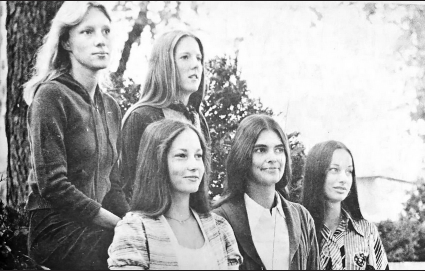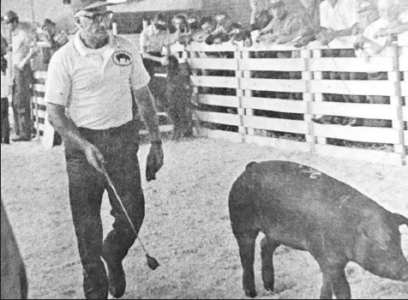METHODIST CHURCH ENJOYS NEW HOME BUILT RECENTLY
First Missionary Came
Here In 1858. Held
Services In Private Home.
——–
INDIANS DESTROYED
FIRST CHURCH BUILT
——–
Rev. C. G. Hohn Has
Been In Charge Of
Parish Thirteen Years.
——–
Early history of the Methodist
Church of this city dates back to
1858 and the little band of workers
at that time would no doubt feel that
their sacrifices were not made in vain
could they but know of the recent
accomplishment of their followers.
The present Methodist Church
building was recently completed at
a cost of $75,000 and is one of the
newest and most modern church
buildings in this part of the state.
Due largely to the efforts of Rev. C.
G. Hohn who has had charge of the
congregation for the past 13 years,
the present building was realized.
His earnest efforts, together with
the loyal support of members of his
church, have made possible the realization
of the new house of worship.
Historical Sketch
A few years after the first white
settlers had come to this city from
Cincinnati, Ohio, and Chicago, Ill.,
the Rev. H. Singenstrue, a German
Methodist minister, was sent to this
locality by the Upper Iowa Conference
of the Methodist Episcopal
Church in 1858 to labor among the
German settlers who up to that time
had been without religious services
of any kind. He came from LeSueur
where he was stationed, making
the trip on horse back. This pioneer
preacher found a welcome reception
with the John Fenske family, residing
about two and one-half miles
from New Ulm. He preached in the
Fenske home and invited neighbors
in to hear the services. Thru his
honest efforts many families were
attracted and the first Methodist Society
was organized in May, 1858.
The first official board of this society
consisted of M. Redmann, Christoph
Schumann, Wilhelm Alwin and
Christoph Gluth.
At the same time Rev. Singenstrue
started a mission station in
Lafayette Township in Nicollet
County where he found a hearty
welcome in the home of Henry Lillie.
Here also he organized a society,
Henry Lillie, Jacob Durbahn, Jurgen
Durbahn, Andrew Draeger and
Henry Schrader, Sr., were the first
official members.
The courageous and enthusiastic
pioneer minister spared no efforts
to gain a foot hold in the little town.
He finally succeeded in securing
the Hiller home as a place of meeting
and he continued to preach the
Gospel and minister to the spiritual
needs of his little flock from 1858
until 1860.
Indians Burn First Church
Rev. Henry Schnitker was the
next itinerant missionary who served
the societies for the next two years.
He was instrumental in the erection
of the first church building which
was burned by the Indians before
it was quite finished. On account of
the Indian Outbreak in 1862, Rev.
Schnitker left this charge and was
succeeded by the Rev. John Haas
who remained only a few months
on account of the continued Indian
trouble.
During the ministry of Chas. Thalenhorst,
1863 to 1864, a log church
was erected on the Jurgen Durbahn
farm in Lafayette township. He was
succeeded in his work by Henry Singenstrue
who remained for the next
three years. Under his leadership a
new brick church was erected on the
corner of State and 3rd North St.,
opposite from the old M. E. Church
building. This was the exact location
of the church destroyed by the Indians.
In 1866 the new brick church
was dedicated.
The Rev. John G. Bauer was
minister during the years 1867 to
1890, Rev. G. Dosdall served as
assistant from June, 1869 until
October, 1870. The two ministers
covered an extensive territory, traveling
from here as far as Beaver
Falls, Birch Cooley, Morton,Sleepy
Eye, Springfield, Fairfax and other
points. These charges served by the
two ministers were organized into
separate stations, or served from different
points until after 1870 when
Rev. Friederich Uhland became pastor.
He preached here, at Lafayette,
West Newton and Cairo or Mud
Lake as it is also called. Rev. Unland
was succeeded by Rev. John M.
Nippolt who served here from 1873
until 1876. Under his administration
a new brick church was erected on
the Jacob Durbahn farm in Lafayette
township which was known as the
Salem church.
Rev. A. Biebighauser took
charge of the local parish in 1876
and remained until 1879. Rev. A.
Dulitz served the Lafayette parish
which had developed into a strong
charge from 1876 to 1878.After
that year the Lafayette charge was
again connected with the New Ulm
charge. Christopher Jahn was pastor
of both charges from 1879 until
1882.
Tornado Destroys Church
On July 15, 1888 a tornado destroyed
the Methodist church. The
following year under the administration
of Rev. G. E. Hilton a new
church was erected which is now
known as the old church located on
the corner of State and 3rd North
Streets. Rev. Hiller served this
charge from 1882 to 1885. Rev. F.
J. Preine, 1885 to 1889; Rev. Henry
Schnitker for the second time 1889 to
1891; Rev. W. E. Baumgarten 1891
to 1895; A. F. W. Krienke, 1895
to 1899; Rev. Geo. Fritze 1899to
Nov., 1901, when he took sick and
died in March 1902. From November
1901 to June 1902, the District
Superintendent Jahon Hauck and
neighboring pastors supplied this
church. During the ministry of Geo.
Fritze an addition was built. In June,
1902, the Rev. Christian Hohn took
charge and served until October,
1903. From October, 1903 to 1912,
the Rev. C. H. Sauter was pastor of
the work. During the ministry of
Rev. Sauter the church of Lafayette
was sold and the local church was
renovated and additions built. Rev.
Hohn next assumed charge for the
second time and is still the resident
pastor. During the administration of
Rev. Hohn the parsonage was considerably
improved.
Present Church was
considerably improved.
In 1923 the present site of the
new church was purchased from
Chas. Brust, Sr., for the sum of
$9,000. The house which stood on
the lot was moved to the old church
property and was made over into a
modern duplex. The location purchased
for the erection of a new
church building was on the corner
of Broadway and Center streets
and made an ideal place to build
the new church. In the fall of 1923
the excavations were started and the
foundations were laid. The corner
stone was laid April 13, 1924, when
Bishop John Neulson of Zurich,
Switzerland, was in the city and had
charge of the ceremonies.
New Ulm Review,
September 16, 1925
————————


